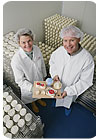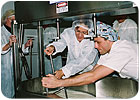
Allison Hooper and Bob Reese with the Signature Line products in Vermont Butter & Cheese’s new facility.
The glass room also provides an excellent setting in which to showcase the multitude of awards the company has garnered since it was established in 1984 as one of the pioneers of American artisan cheese. Visible from the parking lot, are more than a half-dozen trophies from the Fancy Food Show. They stand at each end of the room like sentinels, telling visitors there is something special happening inside.
Adeline Folley, operations mgr. at Vemont Butter & Cheese, says the 4,000-sq ft facility is the brick and mortar result of the efforts by owners Allison Hooper and Bob Reese to take American specialty cheese to a new level.
About five years ago they began producing goat cheeses in the tradition of those made in the storied Loire Valley region of France, beginning with an ash-ripened cheese they called Bonne Bouche, which loosely translates to “good mouthful.” Folley, a French national, studied cheesemaking and microbiology at the national university in Savoie. She first came to Vermont Butter & Cheese for an internship in 2002, returning to join the staff in 2003.
“When I came here I saw that Bob and Allison were making the Bonne Bouche in the same room with the other products, ” Folley says. “I told them, you really can’t do that-you have to build a separate room.”
Since that meant that the growing company would have to suspend production of the new product and invest more than $1 million in the project, Folley half expected to receive a ticket back across the Atlantic. Instead, she was hired to oversee the design, build, start-up and operation of the new facility, which is just under half the size of the company’s main plant.
It took more than two years to complete, but the results are stunning.
Bonne Bouche was reintroduced in 2006 to overwhelming applause. It was soon joined by two other products-Bijou and Coupole-to form a new Specialty Line. The cheeses are a unique addition to the broad array being produced by American artisans. They are made by hand, with painstaking adherence to the techniques and traditions of the classics that inspired them.
All three are wonderfully executed, beautifully packaged and technically brilliant. The Bonne Bouche took second place in its category at the American Cheese Society competition in 2006; it took best of class in 2007 at Wisconsin’s U.S. Cheese Championship, and at the Fancy Food show last year it was recognized as the most outstanding cheese or dairy product.
Meanwhile Folley hosted tours of the facility last summer when the American Cheese Society was held in nearby Burlington. The facility is nearly as impressive as the cheeses.
To ensure the best results from each batch of cheese and a necessary degree of consistency, the company outfitted the new plant with state-of–the-art production and affinage technologies. In particular, that meant an automated computer-monitored air transfer system for the drying and aging rooms. The system, installed by a French supplier, provides precise control of the temperature and humidity in those crucial rooms.
Production remains-by design-a manual process, allowing the company to retain its status as an artisan cheesemaker. But the materials and installations in the make room provide the plant with a level of hygiene that is as high or higher than one would find in most facilities 20 times the size.
Like those larger facilities, the Vermont Butter & Cheese plant is built with the future in mind.
“It was designed so that we can take out a wall and expand it outward,” Folley says.
As the demand for American artisan cheese continues to grow, the need for that expansion could come soon. If nothing else, Vermont Butter & Cheese will need to make room for more trophies.
Somatic Cell Testing in the Barn
Somatic cell counts (SCC) are commonly used on dairy farms as an indicator of udder health and milk quality. Traditionally, most SCC testing has been done with laboratory-based systems. Now, on-farm technologies are being developed that could put testing capabilities directly into the milk barn.One such technology called CellSense has been evaluated for use on Ontario farms by Prof. Randy Dingwell of the Department of Population Medicine. The study compared the CellSense results to those obtained through conventional Dairy Herd Improvement (DHI) tests. They found the cows identified by CellSense for having high SCC were accurate, but that the unit still missed some cows with high SCC.
The in line technology was developed by a New Zealand-based company. A 10-milliliter milk sample to be taken, and it reacts with a gel reagent, and the unit measures the resulting viscosity of the mix as an estimate of SCC. Dingwell says their findings will help fine tune the CellSense unit so it can better identify high SCC animals.
ETCETERA
The Texas Panhandle is one of the fastest growing places in the country for dairy farming. During the past six years, the cow population has ballooned from about 20,000 to 140,000, and the number of dairies has more than tripled to about 70. Thanks to the growth of cheese processing in the area, the herd is expected to grow by 20,000 head annually for the next five years.Patrick Healy, mgr. of Fetzer Vineyard’s Hopland Tasting Room, Hopland, Calif., and one of the earliest advocates for Fetzer’s sustainable business practices, died recently after a long bout with cancer. Healy is known for helping Fetzer become a “zero waste” company, creating a recycling program that reduced company waste to landfills by more than 95% .
Ventura, Calif.-based thinkproducts, a which makes natural nutrition bar, is rolling out a product called think5, a bar that packs the equivalent of five cups of fruits and vegetables. Available in Whole Foods Market, Kroger and Wegmans this month.
Mark Clarke will succeed Tom McKittrick as general manager of World Dairy Expo. Clarke, 39, has been product manager for Bou-Matic, a Madison dairy equipment manufacturer, for the past four years and took over the dairy show’s top leadership position in November.
Oregon goat cheese makers walked away with a record 11 awards this year at the American Dairy Goat Association’s Goat Cheese Competition in Fort Collins, Colo. The competition, held October 16–17, drew nearly 30 commercial goat cheesemakers from across the United States. First-, second- and third-place awards were given in 22 commercial categories. Oregon Cheese Guild (OCG) winners included River’s Edge Chevre, Pholia Farm, Fern’s Edge Goat Dairy, and Silver Falls Creamery.

Petra Cooper of Fifth Town Artisan Cheese in Ontario and Marc Druart of the Vermont Institute for Artisan Cheese (VIAC) cut curd by hand during a course on Spanish cheesemaking held last month at the Institute. The short course brought expert cheesemakers from Spain to teach with the institute’s professors at the University of Vermont in Burlington, which houses the Institute. It was one course in the ongoing Visiting International Experts series-just one of the many programs at VIAC that serve artisan cheesemakers from across North America.